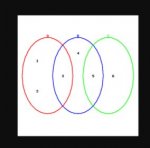A sample space contains six sample points and events A, B, and C as shown in the Venn diagram. The probablities of the sample points are P(1)=0.2, P(2)=0.25, P(3)=0.35, P(4)=0.05, P(5)=0.1, P(6)=0.05. Use the Venn diagram and the probabilities of the sample points to find:
P(C)= 0.15
_ _
P(B|C)=
P(A|C)= 0
I figured out two of the probabilities, but I'm having trouble with the third one. For the first one I added all portions of C to get 0.15. I wasn't able to answer the second one.

P(C)= 0.15
_ _
P(B|C)=
P(A|C)= 0
I figured out two of the probabilities, but I'm having trouble with the third one. For the first one I added all portions of C to get 0.15. I wasn't able to answer the second one.

Last edited:
